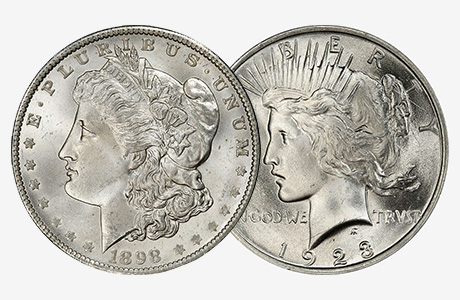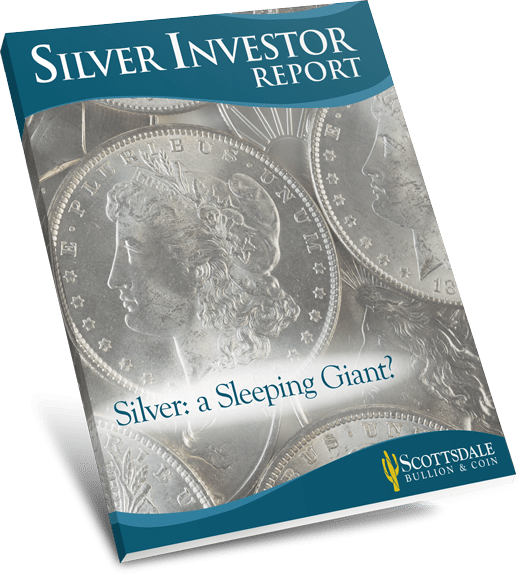 Morgan and Peace Dollars represent two of the most iconic and sought-after silver coins in US history. These popular coins have a lot in common which means their differences are easily overlooked. Understanding the specifics of both Morgan and Peace Dollars can make it easier for investors to choose the right coin based on their investment goals.
Morgan and Peace Dollars represent two of the most iconic and sought-after silver coins in US history. These popular coins have a lot in common which means their differences are easily overlooked. Understanding the specifics of both Morgan and Peace Dollars can make it easier for investors to choose the right coin based on their investment goals.
| Morgan Dollar | Peace Dollar | |
|---|---|---|
| Mint Dates | 1878 – 1904, 1921, 2021 – Present | 1921 – 1928, 1934 – 1935; 2021 – Present |
| Purity | 90% (1878 – 1904, 1921) 99.9% (2021 – Present) | 90% (1921–1935) 99.9% (2021 – Present) |
| Versions | Circulated & Uncirculated | Circulated & Uncirculated |
| Mintings | 657,718,390 | 190,777,279 |
| Mint Locations (Mint Marks) | Carson City (CC) Denver (D) New Orleans (O) Philadelphia (None) San Francisco (S) | Denver (D) Philadelphia (None) San Francisco (S) |
| Face Value | $1 | $1 |
Historical Significance
Morgan and Peace Dollars represent significant periods in American history in terms of the meanings underlying their designs and the motivations behind their mintings.
The Morgan Silver Dollar is intended to represent the fulfillment of the country’s Manifest Destiny in its westward expansion as well as the booming development of the industrial revolution. It holds the distinction of being the first silver coin minted following the Coinage Act of 1873 which temporarily demonetized silver in favor of the gold standard.
As its name implies, the US Peace Dollar celebrates global peace following WWI and America’s new position as a world leader. This classic coin was minted to meet the demands of the Pittman Act which required the production of millions of silver coins. Despite being the immediate successor to the Morgan Dollar, the Peace Dollar was the final silver coin ever produced for circulation in the US.
👉 Suggested Reading: The 2023 Silver Eagle Has Arrived! What You Should Know
Mint Dates
Production of the original Morgan Dollar lasted from 1878 to 1904 with a one-year resurgence in 1921 before the design was replaced by the Peace Dollar. As America’s final circulating silver coin, the Peace Dollar saw two minting periods in its original form from 1921 to 1928 and 1934 to 1935. Each period of production represents individual pieces of minting legislation. Both coins were reissued in 2021 to celebrate the centennial shift between Morgan and Peace Dollars with production slated for the foreseeable future.
Design
The designs of Morgan and Peace Dollars share many similarities, even though they were intended to represent disparate times in US history. Both coins feature a side profile of Lady Liberty on the obverse and a bald eagle on the reverse. However, that’s where the overlap ends.
Obverse
The Morgan Silver Dollar’s Liberty is wearing a simple but elegant diadem depicting the word “LIBERTY” and a Phrygian cap, commonly referred to as a liberty cap. The US motto “E PLURIBUS UNUM” is inscribed on the top, and 13 stars grace the bottom half of the coin. On the other hand, Liberty on the Peace Dollar boasts a radiating crown with flowing locks of hair. “LIBERTY” sits atop the profile with “IN GOD WE TRVST” beneath it.
Reverse
The bald eagle on the Morgan Dollar’s reverse side is clutching a bundle of arrows and an olive branch with its wings spread proudly. A laurel wreath encircles the lower half of the eagle as a symbol of honor and victory. The design is encompassed by “UNITED STATES OF AMERICA” and “ONE DOLLAR”. Alternatively, the Peace Dollar’s bald eagle rests atop a rock looking confidently at the rising sun depicted by sharp rays. “UNITED STATES OF AMERICA” and the US motto adorns the top of the coin while “ONE DOLLAR” and “PEACE” rest at the bottom.
There’s little difference between the original and modern Silver Peace Dollars or Morgan Dollars.
Purity
Investors will be pleased to know that both Morgan and Peace Dollars enjoy high silver purities, in accordance with US law. The initial mintings for each coin feature 90% purity (1878 – 1904, 1921 for Morgan Dollars, and 1921–1935 for Peace Dollars). Thanks to a boom in silver usage and advancements in technology, modern versions of these coins boast a 99.9% silver rating.
Although some Morgan and Peace Dollars hold inherent value beyond their weight in silver, most are only worth their melt value. Unfortunately, some sellers try to pawn off modern, graded bullion coins at prices far surpassing their true value.
Versions
Morgan and Peace Dollars come in circulating and uncirculated varieties, although the overwhelming majority are in the former category. A distinction can also be made between the original and modern versions. The original mintings of these coins were intended for daily use which means most entered circulation. A select few have survived in uncirculated conditions, but it’s important to note this is a minority. Conversely, all modern Morgan and Peace Dollars – those minted since the 2021 reissue – are bullion coins. Since these coins were designed for collecting instead of use, most maintain their uncirculated condition.
Mintings
The US Mint produced over three times as many Morgan Dollars when compared to Peace Dollars. This difference is owed to varied production lengths and the country’s changing coinage landscape. The Morgan Dollar experienced 27 years of production while the Peace Dollar only saw 24 years. On top of that, the US was benefitting from a massive boom in silver production when the Morgan Dollar was issued. By the time the Peace Dollar took its place, there was less of an emphasis on silver coinage.
Are Morgan and Peace Dollars good investments?
Morgan and Peace Dollars are among the most popular investment-grade coins. However, their true merit depends on the unique goals and budgets of each investor. Working with a reputable precious metals expert can help you determine how these coins align with your long-term investment goals. One of our advisors would be more than happy to help. Contact us by calling toll-free at 1-888-812-9892 or using our live chat function.


